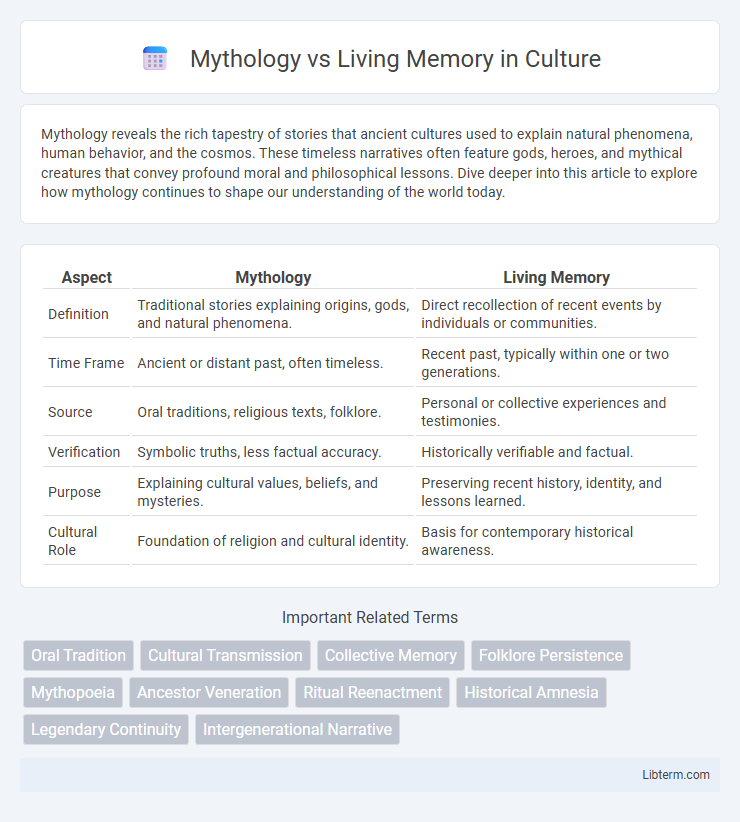Mythology reveals the rich tapestry of stories that ancient cultures used to explain natural phenomena, human behavior, and the cosmos. These timeless narratives often feature gods, heroes, and mythical creatures that convey profound moral and philosophical lessons. Dive deeper into this article to explore how mythology continues to shape our understanding of the world today.
Table of Comparison
| Aspect | Mythology | Living Memory |
|---|---|---|
| Definition | Traditional stories explaining origins, gods, and natural phenomena. | Direct recollection of recent events by individuals or communities. |
| Time Frame | Ancient or distant past, often timeless. | Recent past, typically within one or two generations. |
| Source | Oral traditions, religious texts, folklore. | Personal or collective experiences and testimonies. |
| Verification | Symbolic truths, less factual accuracy. | Historically verifiable and factual. |
| Purpose | Explaining cultural values, beliefs, and mysteries. | Preserving recent history, identity, and lessons learned. |
| Cultural Role | Foundation of religion and cultural identity. | Basis for contemporary historical awareness. |
Understanding Mythology and Living Memory
Understanding mythology involves exploring ancient stories and symbols that shape cultural identities and collective values across generations. Living memory refers to the direct experiences and recollections of individuals or communities within a relatively recent timeframe, often preserved through oral traditions and personal narratives. Examining the interplay between mythology and living memory reveals how societies reinterpret foundational myths in light of contemporary realities and historical consciousness.
Origins: How Myths and Memories Begin
Origins of mythology and living memory often intertwine, where myths emerge from collective experiences encoded through oral traditions and symbolic narratives. Living memory preserves firsthand accounts and tangible histories within communities, shaping identity and cultural continuity. The transformation from personal memory to myth involves exaggeration, metaphor, and communal reinterpretation, anchoring abstract truths in cultural origins.
Transmission: Storytelling Across Generations
Mythology serves as a rich repository of cultural values passed down through oral storytelling, embedding symbolic narratives that shape collective identity over centuries. Living memory relies on direct personal and communal experiences transmitted through narratives, preserving historical events and social practices within a tangible timeframe. The transmission process intertwines, where mythology often emerges from living memory, evolving as stories adapt to new contexts while maintaining core cultural truths.
Fact vs. Fiction: Blurring the Boundaries
Mythology often intertwines with living memory, blurring the boundaries between fact and fiction as stories evolve through oral traditions and cultural retellings. Archaeological evidence and historical records sometimes validate aspects of ancient myths, complicating the distinction between historical events and allegorical narratives. This fusion challenges scholars to discern objective truth within shifting collective memories shaped by social, political, and spiritual influences.
The Role of Myth in Shaping Culture
Mythology serves as a foundational framework through which cultures interpret their origins, values, and social norms, embedding collective wisdom within symbolic narratives. Living memory preserves these myths by continuously adapting and transmitting them through rituals, storytelling, and communal practices, thereby reinforcing identity and social cohesion. The dynamic interplay between static mythological constructs and evolving living memory shapes cultural continuity and transformation across generations.
Living Memory as Historical Witness
Living memory serves as a vital historical witness, preserving firsthand accounts and authentic experiences that bridge past events with present understanding. Unlike mythology, which often blends folklore and symbolic narratives, living memory provides verifiable details that enhance historical accuracy and cultural continuity. This direct transmission of knowledge helps maintain collective identity and supports the critical analysis of historical events through personal testimonies.
Symbols and Rituals: Shared Meaning
Symbols and rituals serve as vital conduits connecting mythology and living memory by embodying shared cultural meanings across generations. These elements function as tangible expressions of collective identity, preserving historical narratives and values through ceremonial practices and iconography. The persistence of symbolic rituals ensures the continuous transmission of tradition, fostering communal cohesion and reinforcing societal norms.
Transformation Over Time: From Memory to Myth
Living memory evolves as individual and collective experiences fade, allowing stories to transform into enduring myths shaped by cultural values and imagination. This transformation often involves the amplification of events, the introduction of symbolic elements, and the blending of historical facts with allegorical meaning. Over time, myths serve to preserve societal beliefs and lessons, transcending the temporal limits of living memory to become foundational narratives.
Societal Impact: Guiding Beliefs and Values
Mythology shapes societal beliefs by providing symbolic narratives that explain origins, morals, and cultural identity, deeply influencing collective values and traditions. Living memory preserves firsthand experiences and personal histories, fostering community cohesion and guiding behavior through direct connection to past events. Together, they form a complementary framework where mythology offers timeless archetypes while living memory anchors societal values in real-life contexts, ensuring continuity and relevance.
Reconciling the Past: Mythology and Memory Today
Reconciling the past involves integrating mythology and living memory to create a cohesive cultural narrative that honors historical truths while preserving symbolic meanings. Mythology offers timeless archetypes and collective identities, whereas living memory provides personal and communal experiences that ground these stories in reality. Balancing these elements allows societies to understand their heritage dynamically, fostering identity that evolves with contemporary perspectives.
Mythology Infographic

 libterm.com
libterm.com